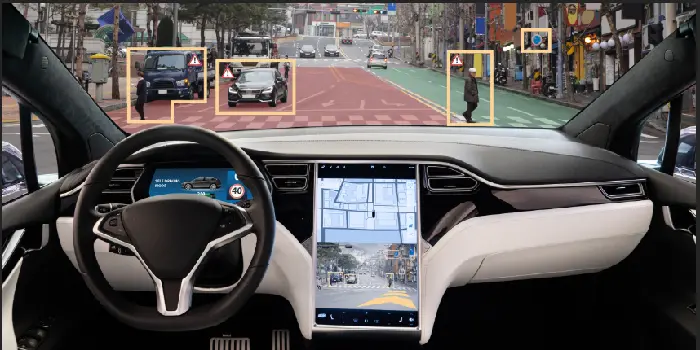AI Glossary
Autonomous Driving – Short Term Explanation
Autonomous Driving, commonly known as “self-driving,” refers to vehicles that operate with little to no human involvement. Once a concept of science fiction, autonomous driving is increasingly becoming a reality through rapid advances in AI and sensor technologies. These vehicles rely on systems such as radar, lidar, and onboard computing to perceive their environment and make driving decisions.
To standardize the progress of automation, the Society of Automotive Engineers (SAE) defines six levels of driving automation, from no automation to full autonomy.

SAE Levels of Driving Automation
To bring clarity and consistency to the development and evaluation of self-driving technologies, the Society of Automotive Engineers (SAE) has defined a standardized framework of six automation levels. These levels describe the extent to which a vehicle can perform driving tasks independently, ranging from full human control to full autonomy. Understanding these levels is essential for interpreting the current capabilities—and limitations—of autonomous systems in real-world applications.
- Level 0 – No Automation:
The human driver is fully responsible for all driving tasks at all times. - Level 1 – Driver Assistance:
The vehicle can support the driver with a single automated function, such as adaptive cruise control. - Level 2 – Partial Automation:
The system can control both steering and acceleration/deceleration, but the driver must remain engaged and monitor the environment. - Level 3 – Conditional Automation:
The vehicle handles all aspects of driving in certain conditions, but the driver must be ready to intervene when requested. - Level 4 – High Automation:
The vehicle can operate independently in specific environments or scenarios, even if the driver is unresponsive. - Level 5 – Full Automation:
The vehicle performs all driving functions in all conditions—no driver attention or presence is required.
This classification system helps manufacturers, regulators, and consumers understand the progress and practical applications of autonomous driving technology.
Autonomous Driving in the Real World
Self driving systems work by creating a picture of the vehicle and the surrounding conditions through a system of sensors. These sensors range from radar to lidar and even laser beams. Information obtained through these sensors is processed by internal computer systems and based on the information provided, the vehicles decide on the right actions. To enhance the development of these autonomous systems, high-quality video datasets for machine learning are essential.
Pundits predicted that by 2020 our roads would be teeming with fully autonomous vehicles. However, currently there are no vehicles on the road that meet the standards set out for full automation. There are some vehicles that are partially automated, however, which does give hope to an eventual future of fully autonomous driving. To advance this future, precise audio data collection is essential for refining the AI systems that power autonomous vehicles.
Tip
To build truly autonomous driving systems, you need large-scale, multimodal training data –accurately labeled and representative of real-world driving environments. LXT delivers AI data solutions that help your models see, hear, and decide smarter.
Autonomous Driving in the World of AI
The benefits of autonomous driving are still to be realized in reality, but they cannot be discounted. A primary benefit includes safety as self-driving vehicles are expected to reduce the number of motor vehicle deaths dramatically. However, another benefit is equalization. Self-driving cars will provide freedom to those that cannot drive due to age or health reasons.
AI will help power this growth, but it is also, to some extent, the reason for its late arrival. AI has progressed in leaps and bounds over the past decade, but having AI fully take on the role of an autonomous driver is still some time away. To adequately train AI systems for autonomous driving, high-quality audio datasets and voice datasets are crucial. For resources on enhancing speech recognition capabilities in your autonomous driving systems, consider exploring audio and voice datasets for speech recognition training. The primary reason for this is the lack of real-world training data to teach AI. Companies are working hard to address this lack, however, and the race is on for a fleet of self-driving vehicles.
